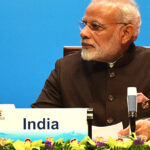
Africa’s relationship with the United Nations began in 1960, when 15 African countries gained independence and 17 became UN member states. In an effort to remove the stain of Western colonialism, the UN embarked on an effort to assist newly independent African states in their right to sovereignty and self-determination.

Many states lacked familiarity with democratic structures, were plagued by ethnic strife, and faced internal struggles for access to political power and access to resources. The first peacekeeping mission on the African continent was established in what is now the Democratic Republic of Congo (DRC) with the support of 20,000 troops.
Fast forward 60 years, and some critics would argue that, despite billions allocated in official development assistance by the UN and major international donors, not enough has been achieved. Africa still suffers from chronic political instability, poverty, hunger, and disease, as well as a resurgence in resource extraction at the hands of foreign powers.
As the United Nations celebrates its 75th anniversary today [21 September], it is important to evaluate the presence and the effectiveness the organization has had on the African continent—from peacekeeping to sustainable human development.
Since the start, UN peacekeeping in Africa has been a miserable failure. Tied to the whims of a Security Council which is less and less capable of performing its basic functions, Africa has not been served well by UN interventions.
This began in the former Belgian Congo, where the naivety of both Dak Hammarskjöld and U Thant in refusing to support intelligence gathering—mainly over a commitment to sovereignty rights and a paranoia about the emerging Cold War—led to poor responses to violent incidents by peacekeepers, as well as the endangering of lives and the overall success of the mission.
In Rwanda, the negligence of the UN Security Council in reducing an already beleaguered UNAMIR force of just over 2,500 to a mere 270 in April 1994, with the genocide against the Tutsis well under way, bordered upon criminal. Later, the UN sent another mission to the DRC, in 1999 to help stop a civil war that had already killed more than three million people.
At one point the Rwandan Army ordered the UN to withdraw from the east of the DRC, which it claimed was being used as a refuge by Hutus who had taken part in the 1994 genocide, despite a Chapter 7 mandate under the UN Charter to use force to protect the peace. Worse, when a UN panel reported that Rwanda and Uganda were prolonging the war to extract wealth from the region, the Security Council vacillated on publishing the report in full.
UN peacekeepers in South Sudan also failed to protect civilians following conflicts between government forces and former rebels in 2016. Today in Mali, peacekeepers are under equipped and lack capacity and human resources. The Security Council, paralyzed by indecision and a reluctance to address resource gaps and personnel shortages, has exacerbated these problems.
Development Goals
The UN in 2015 marked the end of the Millennium Development Goals (MDGs), with measured progress, although Africa started from a relatively low level compared with other regions of the world. Africa’s GDP growth since 2001 has remained positive, with rates of at least 5% compared with the global average of 3%.
Child mortality (under the age of 5) has declined 55% against the target of two-thirds continent wide. The political empowerment of women in Africa increased by at least 15% from 2000 to 2014. The incidence of HIV in people aged 15-49 was halved in Southern, West and Central Africa, and reduced by 46% in East Africa, between 2001 and 2013.
According to NYU economist William Easterly in 2009, the MDGs were always biased against Africa, as success or failure were determined by a set of arbitrary choices that made MDG achievement less likely in Africa than in other regions of the world. For example, the aim of “zero hunger”, in the face of the intensification of climate change effects and food insecurity, proved a bridge too far.
The new Sustainable Development Goals (SDGs), which contain 17 goals with 169 targets and 232 specific indicators, also put Africa on the back foot. While ambitious, financing is paltry and well below the required investment. Already, 20% of all African countries do not raise enough in revenues to essential state functions, while in Sub-Saharan Africa that rate rises to 33%.
This is compounded by a global $2.5 trillion financing gap . The United Nations admits that the goal of poverty eradication isn’t close to being met, and projections suggest that over 23% of Sub-Saharan Africa’s projected 2030 population of 1.7 billion will be living in extreme poverty. In other words, of the 500 million people that will be living in extreme poverty by 2030, 479 million will be from sub-Saharan Africa.
State Responsibility
The UN cannot be blamed for every calamity. States bear just as much responsibility. These include the colonial states of the past and the corrupt, mismanaged states which succeeded them. The UN has sounded warning after warning on a range of African humanitarian crises, with predictably poor responses from the international community. The UN began sounding the alarm in the Sahel region several years ago, asking for more than $2 billion to address food insecurity in the region. Only 60% of pledged funds were received in 2013.
Humanitarian aid shortfalls have plagued UN responses in the region for years. Currently, southern Africa faces an immediate climate change-related emergency, with hunger and food insecurity in many countries at unprecedented levels. Drought, flooding, and economic shocks have left 45 million facing food shortages. In 2019, the World Food Programme (WFP) required almost $500 million to address food insecurity in southern Africa, but received just $205 million.
Africa-based organizations have come to play a more prominent role. These include the African Union (AU), the Southern African Development Community (SADC), and the Economic Community of West African States (ECOWAS). The African Union launched Agenda 2063, a “complementary” set of development goals for the continent. SADC has launched interventions in a number of countries including the DRC and Lesotho, with mixed results. This is not to suggest that such initiatives are replacing the United Nations, rather providing a sense of continent-wide ownership of development and security challenges.
More importantly there are a broader range of development partners, including the recent trend of Chinese investment in infrastructure and resource extraction, without the added burdens of “strings” attached to financing. India and Japan have opened up the Asia-Africa Growth Corridor, which is a competitor to China’s Belt and Road Initiative, and is more harmonized with the UN’s SDGs and Agenda 2063 of the African Union.
Bottom line
The next decade will be crucial in determining the UN’s future in Africa. Competition has eroded some of its power and it no longer has a monopoly on technical expertise. To overcome its mistakes and atone for the past, institutional reforms are necessary, beginning with the Security Council, where Africa could have more sway. To save its long and fractious relationship with Africa, those reforms must start now.






